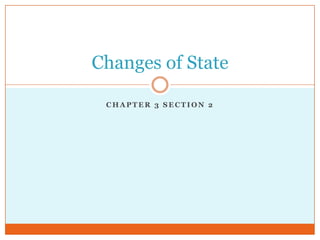
3.2
- 1. Chapter 3 section 2 Changes of State
- 2. Changes of States Particles of a substance at a warmer temperature have more thermal energy than particles of that same substance at a cooler temperature. Thermal energy always flows as heat from a warmer substance to a cooler substance. This explains why on a hot day your ice cream begins to melt in the warm air.
- 3. Changes Between Solid and Liquid Particles of a liquid have more thermal energy than particles of the same substance in solid form. As a gas, the particles of this same substance have even more thermal energy. A substance changes state when its thermal energy increases or decreases sufficiently. A change from solid to liquid involves an increase in thermal energy. A change from liquid to solid is just the opposite: it involves a decrease in thermal energy.
- 4. Changes Between Solid and Liquid The change in state from a solid to a liquid is called melting. In most pure substances, melting occurs at a specific temperature, called the melting point. Since melting points are a characteristic property of a substance, chemists will often compare melting points when trying to identify an unknown material. For example, the melting point of pure water is zero degrees Celsius.
- 5. Changes Between Solid and Liquid When a substance begins to melt it takes energy from the air. This added thermal energy makes the water molecules vibrate faster, raising their temperature. At its melting point, the particles of a solid substance are vibrating so fast that they break free from their fixed positions.
- 6. Changes Between Solid and Liquid The change of state from liquid to solid is called freezing. At its freezing temperature, the particles of a liquid are moving so slowly that they begin to form regular patterns. Just think of when you’re outside in the cold. Do you move quickly, or do you have less energy?
- 7. Changes Between Liquid and Gas The change from a liquid to a gas is called vaporization. Vaporization takes place when the particles in a liquid gain enough energy to form a gas. There are two main types of vaporization: evaporation and boiling. Evaporation is when vaporization only takes place on the surface of a liquid. Boiling occurs when a liquid changes to a gas below its surface as well as at the surface. The temperature at which a liquid boils is called its boiling point.
- 8. Changes Between Liquid and Gas The boiling point of a substance depends on the pressure of the air above it. The lower the pressure, the less energy needed for the particles of the liquid to escape into the air. Places where the air pressure is low, like in the mountains, having lower boiling points. Places that have higher air pressure, like close to sea level, have higher boiling points.
- 9. Changes Between Liquid and Gas The opposite of vaporization is called condensation. Condensation occurs when particles in a gas lose enough thermal energy to form a liquid. You cannot see water vapor. Water vapor is a colorless gas that is impossible to see. The steam above something boiling is not water vapor, they are tiny droplets of liquid water suspended in air.
- 10. Changes Between Solid and Gas Sublimation occurs when the surface particles of a solid gain enough energy that they form a gas. During sublimation, particles of a solid do not pass through the liquid state as they form a gas.